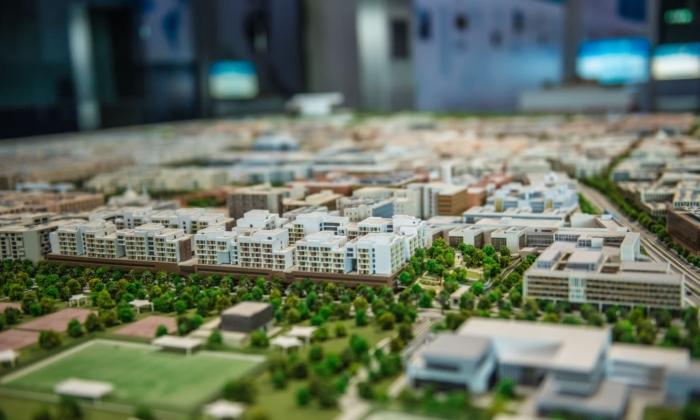The 15-minute city (FMC)—a neat idea, a new way to control the populace, a trendy blip in the public planning industry, a long-term insidious scheme—all, some, or none of these?
As with the gas stove “debate,” any questioning of the latest coolest way to reorganize society is a sign of madness. This haughty reality-shifting attitude somehow pervades the elites despite the deserved devastation of the public’s trust in its institutions in the wake of the pandemic, the response to which involved lies, half-truths, spin, lies, mistakes, lies, the threat of force, lies, the threat of unemployment, the ordered home confinement, the mass destruction of small businesses, and lies.
All of that should be a bit of a tip-off as to the true intentions of the supporters of the idea, but, that being said, let’s discuss the basics.
The idea essentially is to reinvent the neighborhood idea by trying to ensure that pretty much all of the goods and services a person could ever want are readily available nearby. Jobs, schools, doctors, and cultural activities are also meant to be easily accessible. To get to the “15-minute” part, the area would be (based on typical walking speeds) about a square mile or so.
At its heart, the idea harkens back to the village of yore—a place of belonging, simplicity, of knowing your neighbors, of creating a community you can count on in a pinch.
While this may be a key selling point, it cannot be forgotten that for literally hundreds of years people have been purposefully leaving villages to try their hand in the city with its chaos and opportunity, its risks and rewards, and, most importantly, its broadening experiences.
Cities of course already have neighborhoods that are somewhat similar to FMCs, but they tend to be organized around an activity—a meat-packing district, the financial hub, etc.—an ethnicity—Little Italy, Chinatown (sorry, Seattle, I mean the International District), a socio-economic cluster—the westside of Los Angeles versus the eastside of Los Angeles, or even an entertainment activity—Broadway in New York or edgy, anything goes red-light districts like the Tenderloin in San Francisco (NOTE—defining what is happening in the Tenderloin now as entertaining is admittedly a stretch, but before the current stumbling nightmare it was for decades a “rough trade” pleasure zone and one supposes that’s a form of entertainment).
The idea of the FMC, however, is to eventually smooth these differences and create zone after zone of similarly homogeneous neighborhoods throughout a city. As equity is one of the hallmarks of the concept, it might not be terribly fair to have one FMC be notably richer than another, notably different from any of the others.
How to implement an FMC—short of the bulldozer, anyway—is rather complicated because people tend to already be in places targeted for such modification. Zoning, government incentives, planning regulations, public enticements, or simple declarations by fiat have all been proposed to mold existing neighborhoods into FMCs.
In other words, even proponents know that they will not occur organically and need significant government intervention to even get off the ground (another tip-off as to the true intent behind the push).
One of the most important aspects is the elimination of the necessity of a personal vehicle. If practically everything a person needs is so close—literally within walking distance—and if everything else that doesn’t fit—stadium, airport, university, massive hospital and/or museum, etc.—can be easily traveled to by public transit, then do you need an evil, polluting, selfish mobility device? When FMC ideas are rolled out, they do tend to have rather limited parking options—on purpose—as another “benefit” of them is that they are supposed to be better for the environment, more sustainable, more equitable, more whatever woke/equitarian buzzword of the moment you want to use.
Now on to smart cities.
This is a bit simpler because pretty much everything about FMCs applies except with the added bonus that your neighborhood is watching you at all times. Using cell phone tracking, defined shopping habits, health information from your smartwatch, your social media presence, your credit report, you familial status, your hobbies, your habits, and your opinions, a smart city will figure out everything you need even before you know you need it and encourage you to be an overall better person as it defines better people.
In other words, the definition of a needs-taken-care-of, stay-in-your-house-and-shut-up-or-we-will-take-that-away-from-you Nerfified mere existence. You know, hell with ice water.
Not every FMC is a smart city, but most smart cities must be (or at least start out as) an FMC.
And one of the advantages—or hallucinatory disturbing problem—of the FMC is that it is extremely convertible—once established—into a smart city.
In Oxford, England, protestors were told neighborhood travel cordons had nothing to do with the completely separate, no way at all tied together, FMC studies proposed at the same time; especially post-pandemic, with the lies and cudgels and censorship and confinements and lies—people are rightfully calling [expletive] on such facile pronouncements, hence the tension.
But how would a big, diverse in the true sense of the word, city like Los Angeles, for example, be FMCed?
Going a step further than Transit-Oriented Development (TOD)—an existing government-funded trend to get people to live near bus lines and train stations—LA activists are pushing things like the VMT pilot program, dropping parking requirements, and incentivizing smaller, presumably rental (you will own nothing and like it) dwelling units to shoehorn the idea into existing neighborhoods.
- Benefit nearby homeowners and residents with a beautiful walkable street, shops and cafes, and access to transit and bike lanes
- Give every Angeleno the option of an affordable home without the $8,000/year cost and burden of a car
- Create attainable homeownership opportunities that can help close the racial wealth gap
- Reverse-engineer displacement by building in high-opportunity neighborhoods that have not built enough housing
- Address climate change by building car-light infill homes, 48 miles of transit-connected bike lanes, new bus lanes, and 48 miles of new tree canopy
In case you were wondering, the LCI partners with a bevy of the progressive foundational/movement suspects, from Extinction Rebellion to 15 Minute City to Young Entertainment Activists (again, another tip-off).
LCI concepts, smart cities, and FMCs are oppressively top-down systems that shift power of one’s community to the bureaucrat class and intentionally and egregiously ignore same basic facts about how humans act and how a beautiful city like Boston—very very very much not by design—got to be that way.
The FMC movement goes beyond mere planning and architectural niceties. Even if they are not morphed into “smart cities,” certain other governmental agencies and societal elites have multiple reasons. FMCs would make it easier to establish specific community norms, norms that could be at odds with American notions like freedom of movement and speech.
FMCs could also play right into the hands of the forces that brought the world to its knees with their pandemic response. FMCs are not just looked at as making protocols like lockdowns and isolation far easier, they could even be sold as ways to “prevent” future pandemics.
“Living in greater harmony with nature will require changes in human behavior as well as other radical changes that may take decades to achieve: rebuilding the infrastructures of human existence, from cities to homes to workplaces, to water and sewer systems, to recreational and gatherings venues,” Fauci and co-author David Mores wrote. “Since we cannot return to ancient times, can we at least use lessons from those times to bend modernity in a safer direction?”
Another anathema of both smart cities and FMCs is that they need the resident to be the resource that drives them, that their consumer habits be mined and processed in order to make their existence feasible. They do not account for variety of thought or even the possibility of taking advantage of a unique local geographical or industrial or cultural benefit—they are mere consumption machines in which the human is the cog.
While natural neighborhoods can be wonderful supportive safe places, unnatural neighborhoods will exacerbate the problems that do occur in more tightly knit communities. Self-surveillance (if not actual real surveillance) and a sense of trepidation about leaving the comfortable confines can lead to a feeling of isolation from the larger world. In an FMC, that isolation could be seen as being not organic but ordered from on high, creating a mental box that can dwarf intellectual and emotional growth—in other words, a captive personality.
As we have seen from the Twitter Files and so many other recent (and not so recent) revelations about the Censorship-Industrial complex, the real danger of smart cities and FMCs is the potential for the elimination of freedoms, of options, of differences.
That’s not just censorship of thought, it’s censorship of life.





